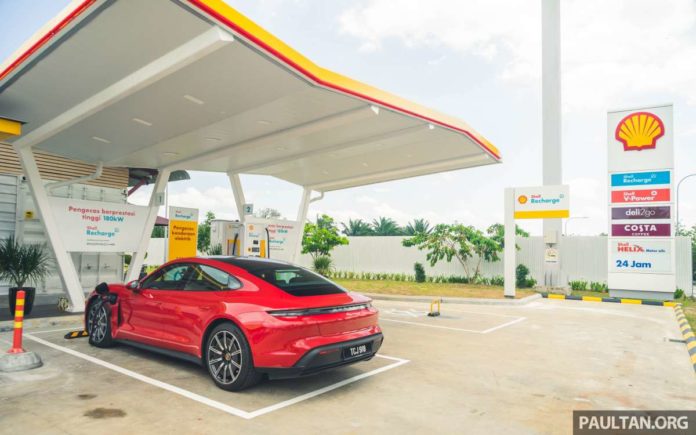Use our referral code R88W3N2T when you download the ParkEasy app and you’ll get some free credits to try it out.
Electric vehicles are the talk of the town, now that these cars are (almost) completely tax free in Malaysia. Sure, you still can’t buy one for the price of a Snickers bar – or, indeed, a Perodua Myvi, and you probably won’t for the foreseeable future – but you can’t deny that these cars are fast approaching the point at which someone who is reasonably well-off can afford one.
But Malaysians are a notoriously hard bunch to please, and the biggest stumbling blocks for these people are range and the charging infrastructure. Time and time again, we see the same comments in our articles – “The range is so short, how can I travel outstation?” or “How can I charge my car when I live in an apartment?” or the perennial favourite, “This public charger, can charge for free ah?”
Clearly then, this country needs a stable, well-developed charging network before a large enough chunk of the buying public will even consider jumping on the electric bandwagon. So it’s a good job that Shell has partnered with Porsche to install a string of fast chargers along the North-South Highway, the backbone of Malaysia’s road network. Sure, not everyone can afford a Taycan, but you don’t need a 761 PS electric sports sedan from Zuffenhausen to reap the benefits – although it would certainly help.
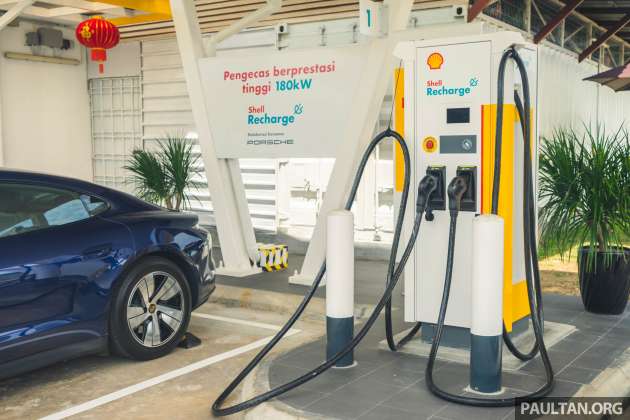
ASEAN’s first “cross-border” charging network – six stations by Q1 2022
The Shell Recharge high performance charging (HPC) network, to give it its full and proper title, is open to the public, although only one of these stations is operational at the time of writing. This is at the Tangkak lay-by near the Johor border, some 170 km south of Kuala Lumpur – the halfway point of a typical KL to Johor Bahru trip.
It won’t be alone for long, as the fuel retailer is planning to implement five more charging stations within the first quarter of the year – the Tapah and Seremban R&Rs for those travelling south on the highway and the Pagoh and Seremban R&Rs and the Simpang Pulai RTC on the northbound side. This means there will be chargers not only down south towards JB, but also all the way up to Ipoh.
All will utilise ABB Terra 184 DC fast chargers, capable of sending up to 180 kW through their two Combined Charging System (CCS) connectors. Users will get the full output with one car plugged in, but if two cars are sharing the same station, they will each receive up to 90 kW of charging power. Unfortunately, because only one charging standard is supported here, you won’t be able to fill up a Nissan Leaf (which features a CHAdeMO socket) or a plug-in hybrid (most of which carry a Type 2 AC port).
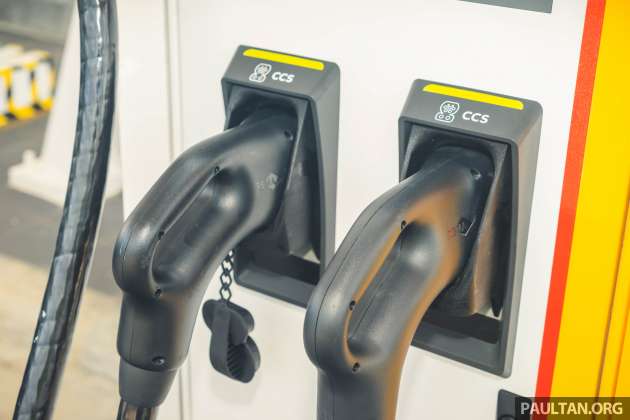
Shell calls this Southeast Asia’s first “cross-border” charging network, as it also incorporates 87 chargers operated by its Singaporean subsidiary Greenlots (soon to be renamed Shell Recharge Solutions) – including 18 50 kW chargers at Shell petrol stations in the republic. The network will soon be expanded into Thailand, with plans for chargers in Bangkok and tourist cities – allowing for road trips right along the peninsula.
The real test – 177 km from Ara Damansara to Tangkak
To test out the new charger, Shell Malaysia and Porsche distributor Sime Darby Auto Performance (SDAP) took us on a road trip from Porsche Centre Ara Damansara to Tangkak along the North-South Highway. This was followed by a scenic drive through Sungai Mati and Kampung Bemban that eventually funnelled us back onto the highway at Ayer Keroh for a straight shot to the showroom. That’s a round trip of around 390 km.
Our chariot was a lightly-optioned Taycan 4S in gorgeous Carmine Red – crucially, without the optional Performance Battery Plus upgrade. Porsche claims a range of between 335 and 408 km on the WLTP cycle, although the company quotes a “real-world” range figure (inclusive of 30% of city driving, 40% on country roads and 30% on highways) of 316 km in our scorching circa-30ºC heat.
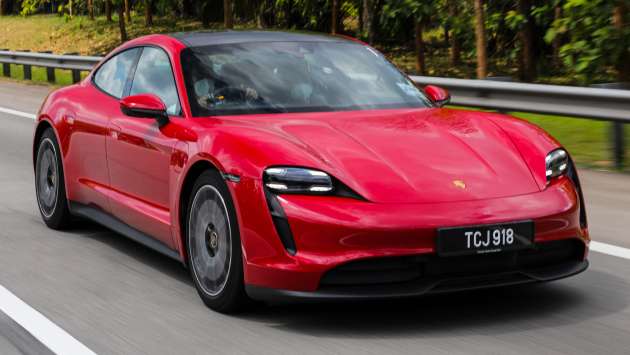
In order to give the car a “proper” challenge, the battery was only topped up to 70%, giving us a range of 270 km according to the sedan’s trip computer. This was still well beyond our 177 km drive to the Tangkak lay-by, although electric vehicles tend to be generous when calculating range. Should we have been worried?
The vast highway section allowed us to stretch the Taycan’s legs, occasionally making use of the all-wheel-drive 4S’ 435 PS (the full 530 PS is only available on overboost when launch control is activated, enabling the car to get from zero to 100 km/h in four seconds flat). Thanks to the two-speed transmission at the rear, the Porsche’s ability to kick us in the backside was undimmed even at higher speeds, flinging us to well beyond the highway limit in an instant.
Even so, our judicious use of the sedate Range drive mode – which minimises air-conditioning use and limits the top speed to 120 km/h – meant that we reached Tangkak with 93 km of range to spare, bang on the car’s estimate. With 23% of battery remaining, we needed a charge to make it back, which in this case required firing the app to book the charger.


Charger bookings made easy
Now, nothing in life comes for free, and neither does charging on the HPC network. Due to local laws, Shell isn’t legally allowed to sell electricity to customers, so it is instead selling the parking spaces next to the charger. To do so, the company has partnered up with ParkEasy, a smartphone app that allows users to book spaces at selected malls, offices, shops, hotels and hospitals. Many of these are fitted with AC charging stations, some of which were installed by Shell in an earlier collaboration with BMW.
Booking the HPC station is as simple as opening the ParkEasy app, selecting the Tangkak charger under “Shell HPC Southbound” and paying the prerequisite RM4 confirmation fee. Once you arrive, you can activate the space in the app, after which the smart barrier will lower, allowing you to park up and plug in. Note that reservations can only be held for ten minutes before they are forfeited.
Now, Malaysia is pretty well-known for being a nation of freeloaders – there have been instances of cheapskates parking next to ParkEasy bays and pulling the charging cable all the way to their own cars.
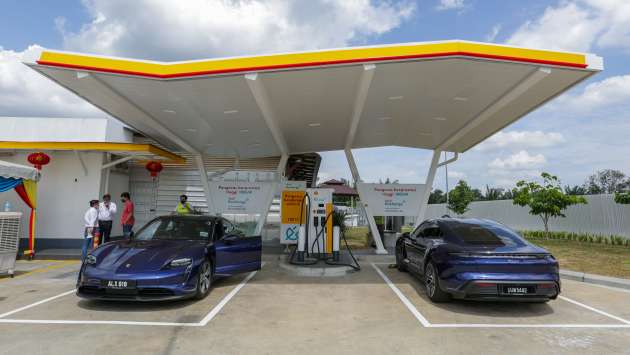
Happily, the spaces at the Tangkak are positioned further inwards and the cables short (thankfully not short enough that they won’t reach a charging port on the far side of a car) in an attempt to thwart unscrupulous drivers from stealing electricity. There’s also the fact that it is out in the open, which should hopefully discourage this embarrassing habit.
Speed and convenience – at a price
That’s good news because, as we’ve reported previously, charging at these stations won’t exactly be cheap. Besides the aforementioned confirmation fee, users will also have to pay RM20 in ParkEasy credits for every five minutes of use. This comes up to RM244 for one hour of charging, which does sting a bit – although the high power output does mean it’s highly unlikely that you’d be stuck there for an entire hour.
Also, because ParkEasy charges you for parking instead of charging, the timer doesn’t stop once you finish charging, only after you leave. As such, any additional time you spend at the Select store or the toilet could be potentially costly – every minute counts.

Helpfully, the price of charging lowers quite a bit if you opt for a Gold subscription. This costs RM835 a year – well north of ChargEV’s rate of RM240 – but in return you pay RM12 per five minutes of charging for the first 25 and RM5 for every subsequent five minutes. That’s RM99 for one hour, but bear in mind that this is only for the first ten hours of use a year, beyond which you’ll need to pay RM80 to top up the quota every hour – after which the discounted rate continues.
There are other benefits to being a Gold Member, including a 10% cash back on Shell Recharge AC chargers and the ability to reserve a spot at a HPC station up to an hour before you arrive. However, you’ll have to buy a Porsche EV – such as the Taycan – to receive the top subscription tier for free.
The Platinum three-year membership drops the cost of charging down to just RM10 for every five minutes of charging for the first 25 minutes, which works out to RM89 for an hour. The quota also increases to 12 hours, while the top up for that quota decreases to RM60 an hour. On top of that, you get a discount of S$0.10 (30 sen) per kWh on the prevailing retail rate when charging in Singapore, applicable to the first 600 kWh a year.


In the end, charging our 4S took pretty much no time at all – at the full rate of 180 kW, the battery went from a state of charge of 23% to 90% in less than half an hour (the elapsed time on the ParkEasy app ended up being 47 minutes, due to the car being plugged and unplugged multiple times for demonstrations). This is despite the Taycan not reaching its maximum allowed charging power of 225 kW.
High-speed charging does not come cheap
Charging our car gave us an additional 266 km of stated range (up to 359 km) and would have cost us RM124 at the standard rate. That seems a little mean, given that the same amount of money in petrol would likely net you double the range in an equivalent Panamera. Obviously, it would’ve been much cheaper with a Gold subscription (RM69), but the large upfront fee will be hard to swallow for most Malaysians.
And let’s face it, not everyone can afford a Taycan and its admittedly attractive Platinum membership (which would have dropped the cost of charging our car to RM59), despite the latest tax-free pricing for the car – even the cheapest model costs a heady RM508,000. The 4S starts at RM595,000, and that does not include the smattering of options fitted to our car.
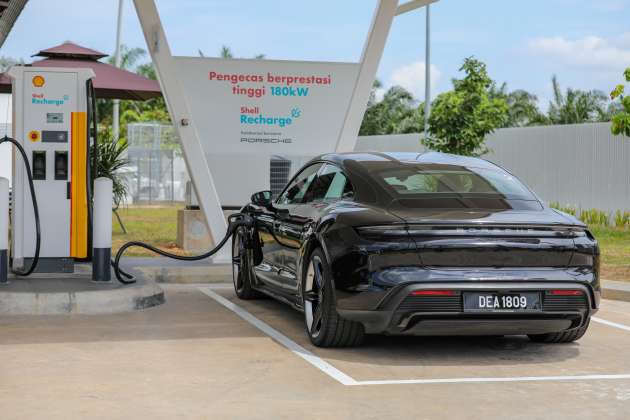
But you have to remember that DC fast chargers are not cheap to begin with. The price of a 180 kW unit like the ABB Terra 184 runs well into six figures, and that does not include the prohibitive cost of installing the charger and the associated safety equipment. Shell has to recoup its investment somehow, and given that the number of EVs on the road is still relatively small, the company has no choice but to charge these rates.
The standard rate is also comparable to other countries. Using a rough calculation, we worked out that the same charging process in the United Kingdom would have cost £23.31 (RM132) at a 150 kW Shell Recharge station, which costs £0.49 (RM2.80) per kWh to use. Granted, Malaysia’s electricity tariff is far lower than the UK’s, but you’re not really paying for the cost of electricity here.
Outdated laws hamper fair charge pricing
Of bigger concern is the fact that our experience was the best case scenario, with just one car being charged. Had there been another car also plugged in, the charging output would’ve been halved, meaning that we would have had to pay double for slower charging. This will probably be the biggest sticking point for Malaysian users, especially as cheaper EVs likely won’t support the full 180 kW output and owners will thus have to pay more than those of more expensive models – you know, the ones who can actually afford it.
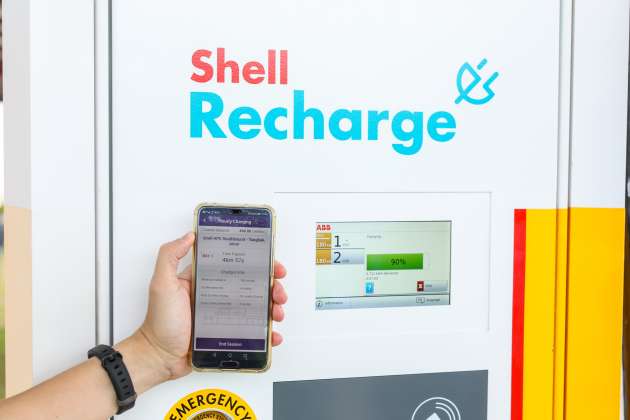
This is the unfortunate side effect of current regulations banning third parties from selling electricity, leading to charging station operators resorting to workarounds like Shell’s ParkEasy deal. Hopefully, the government will reform its laws to facilitate fair pricing for EV charging, as this is a bizarre situation for owners to be finding themselves in.
One thing to keep in mind is that the HPC network isn’t meant for your daily charging needs, as the stations will only be installed along the highway. You’re really only supposed to use it occasionally for long-distance journeys, such as during the usual balik kampung trips. If you’re an EV owner, you’ll mostly be charging your car at home, in which case it’ll be much, much cheaper to run versus a petrol- or diesel-powered vehicle.
Here, you’re paying for the speed, convenience and elimination of range anxiety – things that are valuable on longer drives. It’s up to you to determine if those features are worth the relatively high cost of entry, but one thing’s for certain – road trips beyond city limits will soon be genuinely viable.
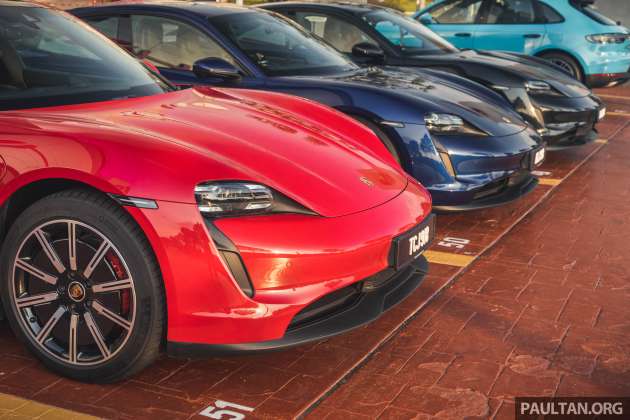
A new dawn for EV charging in Malaysia
The rest of the journey was completed with incredible ease. The Taycan scythed through the federal roads with its incisive, feelsome steering, excellent body control and masses of grip. It’s a shame the traffic prevented us from properly exercising the car’s dynamic abilities, such was the latent potential – as my colleague Matthew found out during his stint with the 4S.
The Porsche’s duality then came to the fore once we jumped back onto the highway, impressing us with its cosseting ride on its air suspension and adaptive dampers and near total lack of powertrain and wind noise – although the 20-inch Michelin Pilot Sport 4 tyres generated a bit of road roar at higher speeds.
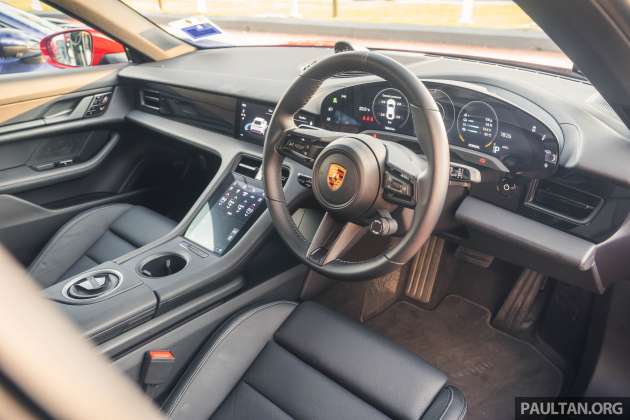
Even though we drove a little faster on the way back to Ara Damansara, we still had 35% of charge remaining with an estimated 141 km of range left (a reduction of 218 km in quoted range, versus the actual journey length of 212 km). At no point did we have to slow to a crawl to match the car’s calculations, which was an impressive feat in its own right.
At the end of the day, the drive gave us a glimpse of the future – one where a growing network of fast chargers and ever-increasing range make the case for an EV as the only car you will ever need. It may be a little expensive for now, but it’s a vision that’s definitely compelling.
GALLERY: Porsche Taycan 4S in Malaysia

